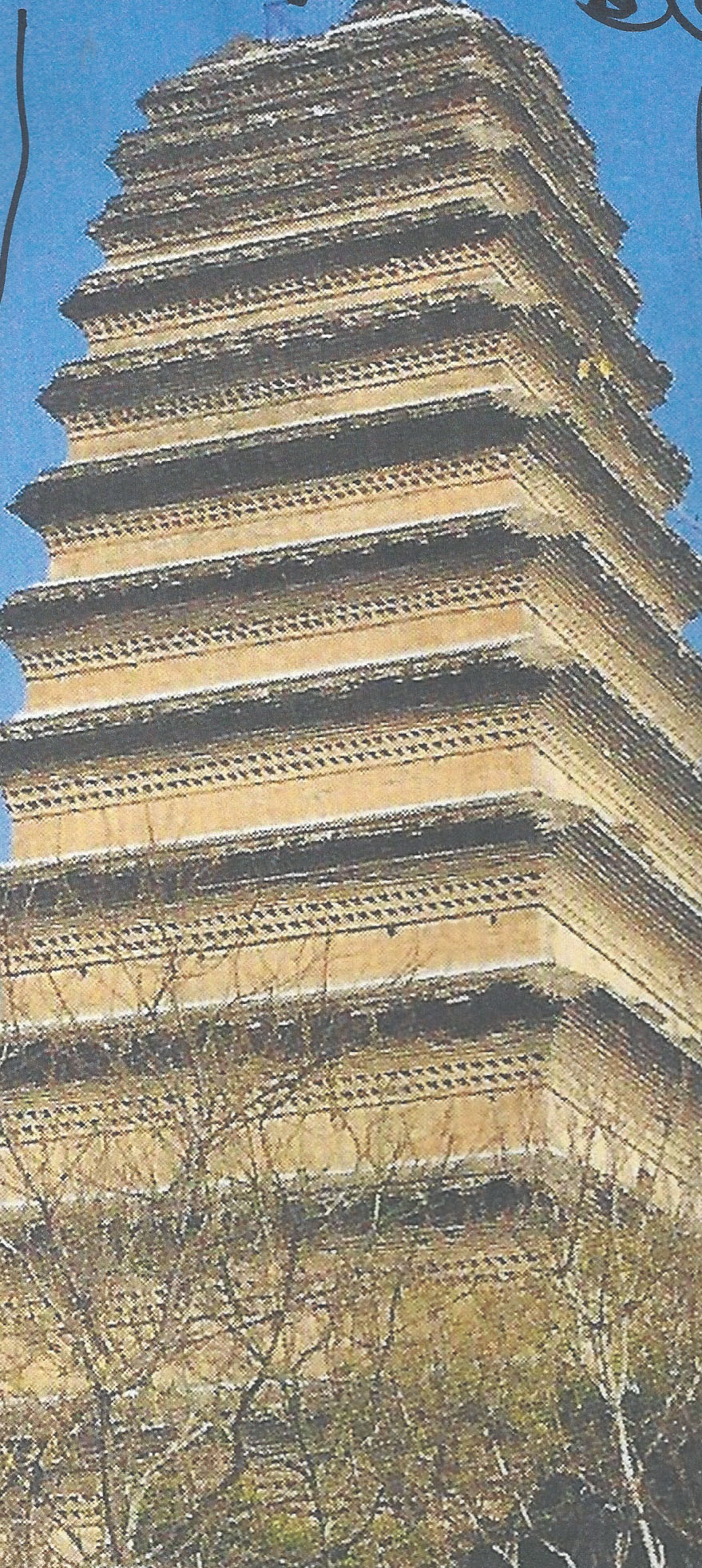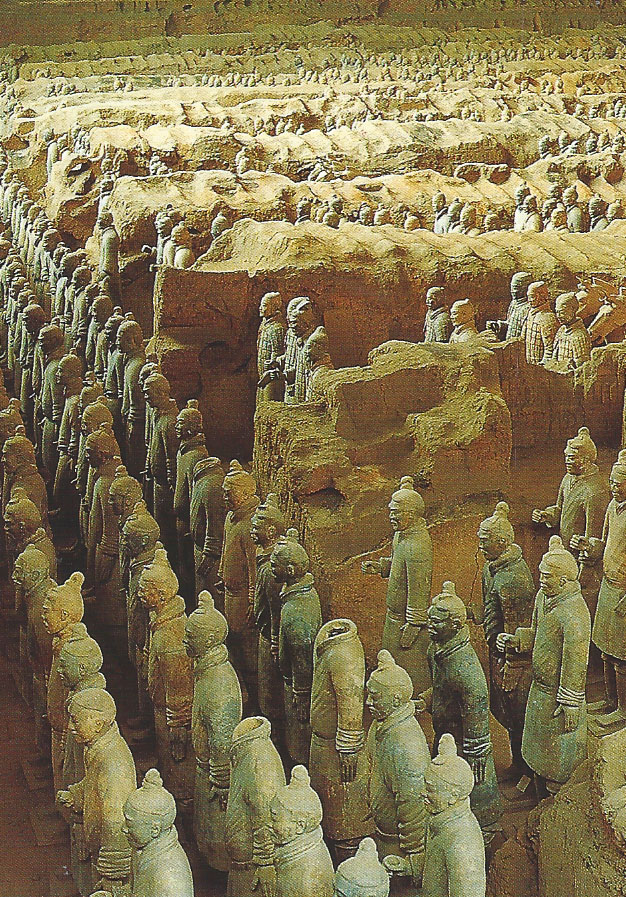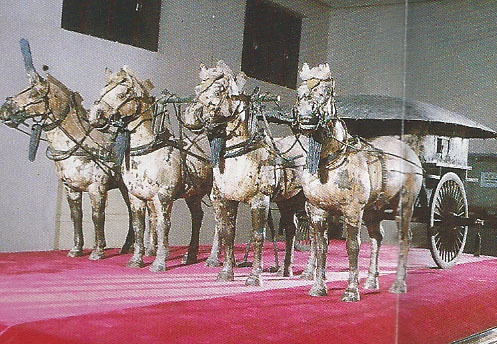
| What is Flavor and Fortune? |
| How do I subscribe? |
| How do I get past issues? |
| How do I advertise? |
| How do I contact the editor? |
Read 12883387 times
Connect me to:
| Home |
| Articles |
| Book reviews |
| Letters to the Editor |
| Newmans News and Notes |
| Recipes |
| Restaurant reviews |
| Article Index (all years, slow) |
| List of Article Years |
| Article Index (2025) |
| Article Index (last 2 years) |
| Things others say |
| Related Links |
| Log In... |
| Authors |
| Categories & Topics |
Xian: An Early Chinese Capital
| by Jacqueline M. Newman |
Food in History
Spring Volume: 2016 Issue: 23(1) page(s): 7 to 8
This capital of the Shaanxi Province, in early times was called Chang‘an. It was the first capital of the Qin Dynasty from 221 to 206 BCE. It remained the capital during the Han Dynasty (206 BCE - 220 CE), and four hundred years later again became the capital during the Tang Dynasty (618 - 907 CE). In its early days, it this city was very cosmopolitan, a place where many foreign nationals lived, and many of them owned property here.
Now called Xian, this central Chinese city in the Wei River valley was the eastern gateway to ancient China’s Silk Road. People know about it because of that and its capital associations, and because of the eight thousand terra cotta warriors buried here that were uncovered thousands of years later as the burial place of Shi Huangdi, the Qin emperor. These days people flock twenty miles from downtown to see these soldiers keep that keep company with the chariots, horses, and other archeological findings.
 In addition, this city is home of the Big Wild Goose Pagoda which we wrote about in Volume 21(4) and it is the home of the Small Wild Goose Pagoda, the Xian Museum, the Bell Tower, and many other things.
In addition, this city is home of the Big Wild Goose Pagoda which we wrote about in Volume 21(4) and it is the home of the Small Wild Goose Pagoda, the Xian Museum, the Bell Tower, and many other things.  The Big Wild Goose Pagoda, actually smaller than the Small Wild Goose pagoda, was completed in 709 CE to house the more than six hundred Buddhist scrolls, correctly known as sutra’s, that were found along the Silk Road and brought to China from India. It was built specifically to house them after the monk who found them asked the local government to build this place for them. One of these pagodas is actually in a southern suburb one mile from the city wall.
The Big Wild Goose Pagoda, actually smaller than the Small Wild Goose pagoda, was completed in 709 CE to house the more than six hundred Buddhist scrolls, correctly known as sutra’s, that were found along the Silk Road and brought to China from India. It was built specifically to house them after the monk who found them asked the local government to build this place for them. One of these pagodas is actually in a southern suburb one mile from the city wall.
The smaller one is two hundred ten feet tall and was last renovated in 1964. It and the terra cotta statues are unique. The Small Wild Goose Pagoda is more than a dozen stories tall or one hundred forty-one feet tall, six feet shorter than when it was built due to an earthquake in 1556. Its larger named sibling, though called ‘the Small Wild Goose Pagoda’ is actually taller. The one known as ‘small’ was built to honor that Monk, Xuanzang, who in 652 CE brought these sutra rolls back to China during the Tang Dynasty. It was rebuilt in 704 and monk Xuanzang’s statue stands in front of it. Though the pagoda did start to recline somewhat in 1719, it has since been straightened up.
Xian has a museum with more than two thousand historic relics, the Sutra Depository, the Jianfu Temple which was built in 684 CE, and other places worth visiting. This pagoda is one hundred forty-two feet tall, each story smaller than the one under it. The doors face north and south and have overlapping bricks curving inward. It was built in 707 CE and locals call it both dainty and exquisite. The Jianfu Temple was built earlier, specifically in 684 CE. The Small Wild Goose pagoda became a World Heritage site in 2014, and one of its many wonders is that though in an earthquake zone, it has remained standing during more than seventy of them.
The Bell Tower was completed the 14th century and repaired in 1739 CE. It is near the rammed earth city wall, is unique and it was built during the Sui Dynasty (581 - 618 CE), repaired in 1586, and repaired again in 1781. As one of China’s best preserved city walls, now covered with gray bricks, it is eight and a half miles long marking the outline of what was the city when it was built. There are three gate towers, and soldiers did man them protecting the city’s royal and ordinary occupants then. They are not manned today.

 At the terra Cotta warriors, one sees that every warrior has different facial features, different hats, and unique hands and hair; each horse is different, too. This archeological find is seen as originally built and buried; and nowadays it is viewed from a gallery. Not so when we first visited there in 1978. Then just four warriors were in a garage-type building on display in a very small space. Now, they are in a many-football-field size facility as originally set out to protect the emperor. Visitors see them from a raised gallery and sometimes see archeologists cleaning them or uncovering still others.
At the terra Cotta warriors, one sees that every warrior has different facial features, different hats, and unique hands and hair; each horse is different, too. This archeological find is seen as originally built and buried; and nowadays it is viewed from a gallery. Not so when we first visited there in 1978. Then just four warriors were in a garage-type building on display in a very small space. Now, they are in a many-football-field size facility as originally set out to protect the emperor. Visitors see them from a raised gallery and sometimes see archeologists cleaning them or uncovering still others.
The original intent of this stone army was to protect the emperor. It was started when he was thirteen years of age and took thirty-nine years to complete the thousands of figures, chariots, warriors, infantrymen, cavalry men, and horses there to protect him.
Called by many, the eighth wonder of the world, this huge army of men, chariots, and horses became a World Heritage Site in 1987. It was not intended as the tourist attraction it now is, but rather as an army to protect the emperor in his after world. They stand in rows as originally found, and they are very impressive.
Xian is an exciting city to visit and it now is on China’s culinary scene. The most popular recipes there are the Bread and Mutton Soup, the many dumplings, and some other very good food. A Letter to the Editor, in this magazine’s Volume 22-3, does discuss this local specialty, their Steamed Buns which the dumplings are called, and that Mutton Soup. There are many restaurants that serve one or both, quite a few have variations of them. Some residents recommend having yours at Old Sun’s located in the center of the city where Master Calligrapher Yu Youren ate his as did generals Zhang Xueliang and Yang Hucheng. Different people eat this soup in different ways, and visitors do comment that it has no ‘smelly sheep aroma’ though it is thick and fatty, the latter providing its aroma from the sheep's tail, and almost every one tears apart the bread putting it in different size pieces.
Su Dongpo, an early poet, said this soup has the “taste of the old Qin Dynasty.” We did find a picture in an old magazine and share it on this page, and we share a picture of one of the most popular Muslim restaurant groups in this city. They have three places, all owned by the same group, and many tourists and locals do go here and eat and enjoy this soup and other local foods. We did eat it in one of these locations before the newer ones were built that look large and lovely. Called Xuan Fangshangren, their three locations are said to be expanding, one moving, so do check out the locations at www.fangshangren.com and do make note of their addresses and phone numbers. Many ask us not just where to eat but where to bed down. Prices vary as does the quality of accommodations and the quality of available food. On our last visit to Xian we stayed at the Xian Garden Hotel at 40 Yan Yin Lu; its phone is: 029-8760-1111. We ate in many of its famous places.
We have returned to the Xian Yuanhao Huazang Museum, and still believe that some of their Buddhist art is spectacular. On a different occasion, we returned to the Banpo Neolithic Museum on Banpo Road near Changle Road across the street from the Banpo Matriarchal Museum. We suggest you visit both and all other Xian historic sites. They are spectacular and a real thrill to see. It is great to learn about this ancient matriarchal society and its relics.
On our first visit here, we ate at the only large dumpling restaurant then. Now there are many as this city specializes in dumplings and their famous soup. Most are terrific, as are the Jiaozi banquets many of them have. The first one we ate in dozens of years ago did serve us thirty dumpling courses, each holding smaller dumplings that the previous one. They went from the biggest which was the size of a big man’s fist to very small ones less than the size of the nail on a child’s smallest finger.
Since, we have dined at DEFACHANGE JIAOZI RESTAURANT; 18 ANBAN LU; Phone: 8629-8721-4060 on several occasions. It is also known for its Tang Dynasty style wine originally made by the Xu family whose recipe is still in use. They still serve their famous wine and their well-known calabash-shaped chicken; do try them both. Also try the XIAN RESTAURANT; 298 DONGDAJIE STREET; phone: 8629-8727-3821. The first time we had the local Mutton Soup previously mentioned, it was at TONGSHENGXIANG MUSLIM RESTAURANT; phone: 8629-8721-7512. This place is one of the oldest in this city and dates back to the turn of this century.
There are other foods known in Xian. This magazine has written about some of them so check out the recipe index, also the cookbooks in their index, and look on the web and elsewhere, too. Foods now considered local and luscious in this city are many, so we try to go there often to enjoy them. The soup is called Yang Rou Pao Mo or Lamb Soup with Torn Bread. You can also enjoy a some of their local foods in your own kitchen by tring the recipes below.
| Bobin Pancakes |
|---|
2 cups all-purpose flour 1 teaspoon coarse salt 1 Tablespoon sesame oil 1 cup coarsely chopped scallions, the green parts, only 1/4 pound soft doufu, mashed 1/4 pound boiled pork belly, diced finely 1/4 pound bamboo shoots, finely minced 1/4 pound carrots, peeled and finely minced 2 ounces any skinless and boneless whte fish 1 teaspoon coarse salt 2 teaspoons granulated sugar 1/4 teaspoon finely ground white pepper 3 Tablespoons minced pine nuts 1/4 cup coarsely chopped coriander leaves 3 Tablespoons cornstarch 3 cups vegetable oil 1 teaspoon chili paste with garlic 2 Tablespoons hoisin sauce 1 teaspoon plum sauce Preparation: 1. Stir the flour and salt in a bowl and make a well in the flour mixture and pour in one cup of boiling water, then stir the dough into a ball, brush it with the sesame oil, cover and allow it to rest for ten minutes. Next knead until smooth, incorporating the scallion pieces. After that, cover and let rest for an hour. Now divide this dough into twenty parts, and then roll each one into a six-inch thin circle, and stack them in sets of two. 2. Make the filling by mixing the bean curd, belly pork, bamboo shoots, carrots, fish salt, sugar, pepper, pine nuts, and the coriander leaves. Divide this into twenty portions, one for each batch of dough put it on the dough and fold in the sides. Using wet fingers, fold in the edges, and let this rest until all are made and filled. 3. Mix some flour and three tablespoons of cool water and make a thin batter. Dip the filled dough, two by two, into the batter. 4. Heat a wok, add the oil, and fry these pancakes until golden and crisp; then drain each on paper towels, and serve with the dipping sauce which is a mixture of the chili sauce, hoisin sauce, and plum sauce to be served on the side. NOTE: Some gently roll the filled dough into one fat snake, wet it lightly then roll it around and around making a circular pancake. Pat it down gently, and fry them in the preheated oil on both sides, one at a time, then drain on paper towels. Serve with the dipping sauce mixture on the side. |
| Boneless Ribs |
|---|
5 pounds flank steak (can use boneless pork) ½ cup vegetable oil 3 scallions, each tied in a knot 5 slices fresh ginger, peeled 2 Tablespoons Chinese rice wine ½ cup dark soy sauce 2 Tablespoons granulated sugar 5 scallions, cut into one-inch pieces 2 Tablespoons Chinese black vinegar 1 Tablespoon sesame oil Preparation: 1. Heat a large pot, put a hole into the meat the long way, then add the knotted scallions and the ginger. Fry for two minutes, stirring often, then remove the meat and drain it on paper towels. Discard the oil and the knotted scallions. 2. Return the meat to the pot, add the rice wine, soy sauce, and the sugar, and stir well, then add two cups of boiling water, reduce the heat and simmer stirring every five minutes for forty-five minutes or until the sauce is reduced to less than a cup. 3. Remove the meat to a platter. One can stuff one scallion piece into each piece of meat then return the meat to the pot. Add the vinegar and simmer for five minutes, then add sesame oil, and serve. |
| Chicken Wings Stuffed with Doufu |
|---|
30 two-bone chicken wings 1 three-inch piece firm doufu, cut into matchstick-size pieces 1 three inch piece of daikon, cut into match-stick pieces 6 dried Chinese black mushrooms, soaked for twenty minutes, stems removed and discarded, caps cut into matchstick pieces 1/4 pound watercress 1 Tablespoon Chinese black rice wine ½ cup chicken broth ½ teaspoon coarse salt 1 teaspoon cornstarch Preparation: 1. Simmer the wings for three or four minutes, then when cool enough to handle, remove their bones. 2. Mix together the doufu, bamboo shoots, and mushroom pieces. 3. Put one scant piece of the vegetable mixture stuffed into each wing cavity, do not over stuff them. 4. Steam the water cress for one minute, then squeeze out the excess water and arrange this green around the outside of a round platter. 5. Arrange the wings in a heat-proof ceramic bowl that fits into the steamer, mix the wine, broth, salt, and sugar, and pour over the wings, and steam them covered for twenty minutes. Drain the liquid with the wings into a wok or small pan, add an ice cube and the cornstarch, mix well, and stir as it boils. When thick, pour this over the wings and greens and serve. |
| Deep-fried Hard-cooked Pigeon Eggs |
|---|
1 cup vegetable oil 2 cups shallots, peeled, skins removed and discarded, each shallot cut in half 20 hard-cooked pigeon eggs, peeled 2 Tablespoons maltose ½ teaspoon coarse salt 2 Tablespoons oyster sauce Preparation: 1. Heat wok or small deep pot, add the shallots and deep fry them until crisp, then remove and drain on paper towels. 2. Add the eggs to the wok or pot, and deep-fry them for two or three minutes, then remove and drain well. 3. Remove all but one tablespoon of the oil and reserve. Then cut each egg in half. 4. Put half the shallots on a small serving dish, top with the egg halves, then add the rest of the shallots on top. 5. In a small pot or wok, heat the reserved oil, then add the sugar, lemon juice, salt, and oyster sauce and bring this mixture to the boil stirring it. Pour it over the shallot and egg mixture. Now serve. |
| Cloud Ear Fruit Soup |
|---|
½ cup glutinous rice, soaked overnight 20 dried longan, boiled for twenty minutes, each cut in half, the pits discarded 1 cup mung beans, boiled for half an hour, then remove and discard their skins 20 goji berries 1 ounce white tree ear fungus, soaked for an hour, any hard centers discarded ½ cup granulated sugar ½ cup barley, simmered for one hour, then drained Preparation: 1. Drain the glutinous rice. Bring six cups of cold water to the boil, add the rice and simmer for one hour. 2. Now add the longans, mung beans, goji berries, white tree fungus, sugar, and cooked barley, and bring to the boil, reduce heat and simmer for an hour. 3. Cool to warm, and serve in individual bowls. |

Copyright © 1994-2025 by ISACC, all rights reserved
Address
3 Jefferson Ferry Drive
S. Setauket NY 11720